Papers by SUBSAHARAN JOURNAL OF MULTIDISCIPLINARY RESEARCH AND INNOVATION
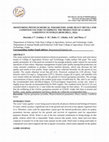
SUBSAHARAN JOURNAL OF MULTIDISCIPLINARY RESEARCH AND INNOVATION
This study analyzed and monitored physicochemical parameters, condition factor and some heavy met... more This study analyzed and monitored physicochemical parameters, condition factor and some heavy metals in College of Agriculture Science and Technology, Gujba earthen fish pond. The water quality parameters of a fish pond are essential to be manage properly under control for successful operations of fish culture. Improper management of pond water quality during fish production can create stressful conditions to produce various harmful diseases, which may decrease the fish quality and results in low profits. Water samples were collected biweekly for the period of two months. The results obtained reveal that pH (8.8), Electrical conductivity (228 μS/cm), Total dissolve solid (154 mg/L), Temperature (250C), Dissolve oxygen (8.35 ppm), and turbidity (33) were found within the tolerable limit for the growth of Clarias gariepinus juveniles. The average concentrations of heavy metal in the earthen pond water revealed that Fe, Mn, and Cu are within the recommended limit ((0.596±0.43ppm, 0.472±0.23ppm) respectively except zinc which is slightly lower that the recommended limit (0.1930.11ppm). The condition factor (k) of (1.31) was recorded which is found to be ≥1 and within the normal range for fish culture. It’s recommended that the wellbeing of the Clarias gariepinus juvenile in COAST, Gujba fish farm is normal and healthy, water quality parameters and heavy metals are within the recommended limit.
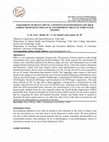
SUBSAHARAN JOURNAL OF MULTIDISCIPLINARY RESEARCH AND INNOVATION, 2024
Milk is a very important component of human diet. The presence of heavy metals in milk at high co... more Milk is a very important component of human diet. The presence of heavy metals in milk at high concentration may create significant health problems. This study assessed the concentration of Arsenic (As), Lead (Pb),Cadmium (Cd), Mercury (Hg), zinc (Zn) and Chromium(Cr) in cow milk samples (Pasteurized) got from selected Local Government Areas, Yobe State namely: (Damaturu and Potiskum) within Yobe state, Nigeria. Heavy metal determination was done according to standard procedures. Heavy metal concentrations (As, Pb, Cd, Hg, Zn and Cr) were assessed by the use of Atomic Absorption Spectrometer (AAS). The Aggregate mean content of the heavy metals in the sample of cow milk from the two Local Government (Damaturu and Potiskum) were, Arsenic (As) 0.02525mgl-1, Lead(Pb) 0.84269 mgl-1,Cadmium(Cd) 0.04238 mgl-1,Mercury (Hg) 0.85556mgl-l, Zinc(Zn) 0.26031mgl-1 and Chromium (Cr) 0.28700 mgl-1 respectively. The result shows that the As, Pb, Cd, Hg, and Cr Mean aggregate concentrations in Pasteurized cow milk samples collected from all the two Local Government areas (Damaturu and Potiskum) were all above the WHO permissible limits. However, the concentrations of Zn in the cow milk samples (pasteurized) obtained from the area remained within the World Health Organization (WHO) permissible limit. Statistical Package for Social Sciences (SPSS version 23) was used to analyze data by computing the mean and standard deviation. Routine and further study is required to determine the heavy metals status in cow milk from other LGAs of the State to ascertain the safe levels of cow milk products to consumers in the area

SUBSAHARAN JOURNAL OF MULTIDISCIPLINARY RESEARCH AND INNOVATION, 2024
Family planning is one of the established standard procedures used in controlling issues associat... more Family planning is one of the established standard procedures used in controlling issues associated with fertility which account for economic and social challenges in response to available family planning facilities and is a cost-effective strategy for socio-economic development, any penny spent on family planning result in maternal and child mortality reduction and helps in social and economic benefit in many sectors such as food, water, health, shelter and also can accelerate progress in 7 out of the 17 SDGs Goals(UNFP2017 ). The study assesses awareness and available family planning facilities in Damaturu local government area. The instruments used for data collection were questionnaire, focus group discussion (FGD and Key Informant Information (KII) survey methods while the data were analyzed using descriptive statistical techniques such as percentages, charts and ratios. The findings revealed that there is significant level of awareness on fertility regulation methods as 70.1% of the respondents were aware of the different modern methods of fertility regulation as against 29.9% of the respondents who were unaware. The available family planning facilities discovered to be available in the study area include: Federal polytechnic clinic, Police barrack clinic, Family support specialist hospital, General specialist hospital, Maisandari phcc, Gwange phcc, Nayi-nawa phcc, Marfa-kalam phcc, Dikumari phcc, Malum Mattari phcc, Kalallawa phcc, Gabai phcc, Kasaisa IDP camp, Kuka-reka phcc, Damakasu phcc, and Gambir phcc. The instrument used include: Manual Medical Eligibility Criteria Wheel (MECW), the circle bead, wooding Penis, Injectable Noristerate, Microludag, and Intra utenary copper device known as Copper T, (I.U.C.D) Condom and Microgenan. KII respondents confirmed that “same of the instrument has finished”. The compliance on the use of modern method in both the rural and urban Damaturu was discovered to be very low and the reason why 90% of the respondents are not using modern method is fear of side effect, lack of awareness and low literacy level. In conclusion the study points to a need for better fertility regulation in the study area where inadequate supplies of modern methods contribute to a low prevalence of modern method.

SUBSAHARN JOURNAL OF MULTIDISCIPLINARY RESEARCH AND INNOVATION, 2024
This study assessed information needs of cassava farmers in Ikom Agricultural zone, Cross River S... more This study assessed information needs of cassava farmers in Ikom Agricultural zone, Cross River State. Specifically, it determined the information needs of cassava farmers, identified sources of information for cassava production and discussed the constraints to the use of ICT tools for cassava production. A multi-stage sampling technique was used to select 190 cassava farmers for the study. The data was collected with a well-structured questionnaire and analyzed using descriptive statistics. The results show that (97%) of the farmers need information about where to sell their products, (85.7%) need information about agricultural loans and credits, (85.1%) need information about weather condition and flood warning and (78%) need information about current and future market price forecast. With regards to sources of information, the study found out that the majority (90.5%) of the farmers get their information from mobile phones, personal experience accounted for (85.3%) and friends and family (81.1%). The findings also show that low adoption and utilization, access to credit sources, high cost of ICT tools and high level of poverty were the major constraints to the use of ICT tools for cassava production in the study area. The study recommends that key stakeholders should be encouraged to provide affordable credit facilities to farmers to reduce the financial burden of acquiring and maintaining certain ICT devices.
SUBSAHARAN JOURNAL OF MULTIDISCIPLINARY RESEARCH AND INNOVATION, 2024
A case of 5 year old crossed (Yankasa and Balami) ewe was presented with the chief complaint of p... more A case of 5 year old crossed (Yankasa and Balami) ewe was presented with the chief complaint of progressive weight loss despite good appetite, reduced feed intake and emaciation. History revealed that, the sheep was the only one affected in the flock. Physical examination revealed distended abdomen, rough hair coat, emaciation and mild dehydration. The vital parameters (pulse rate, respiratory rate and rectal temperature) were all within the normal range. Upon abdominal palpation, a hard mass on the left side of the abdomen (paralumber fossa). This revealed the presence of a foreign body within the rumen and rumenotomy was instituted. The impacted mass comprises of nylon ropes, polythene bags and hairball, weighing 10.6kg.The surgery was successfully done without any complication.

SUBSAHARAN JOURNAL OF MULTIDISCIPLINARY RESEARCH AND INNOVATION, 2024
This study explored the prediction of body weight in goats using linear body measurements in Ebon... more This study explored the prediction of body weight in goats using linear body measurements in Ebonyi State, Southeastern Nigeria. Records were taken on a total of 372 goats (151 males and 221 females) kept by traditional farmers under extensive system of production, covering six out of the thirteen Local Government Areas (LGA), two from each of the three senatorial districts of the State. In each LGA, 15 livestock farmers were selected at random and body measurements were taken from a random sample of 2-5 goats depending on the flock size. There was high, positive and significant (P<0.01) correlation between body weight and among linear body measurements (Heart Girth, Body Length, Height at Withers and Hip width). Highly significant (p<0.01) coefficient of determination was recorded for three regression models used. The relationship between body weight and linear body measurements was best described by the quadratic equation. The R value for the male was higher than that of the female goats. A stepwise multiple linear regression showed that heart girth, height at withers and body could be used to predict body weight, with heart girth being the single linear body measurement that can predict body weight with high degree of reliability. Hip width is not reliable for prediction of body weight from linear body measurements.
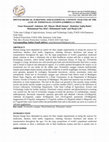
SUBSAHARAN JOURNAL OF MULTIDISCIPLINARY RESEARCH AND INNOVATION, 2024
Human beings have depended on nature for their simple requirements as being the sources for medic... more Human beings have depended on nature for their simple requirements as being the sources for medicines, shelters, food stuffs, fragrances, clothing, flavours, fertilizers and means of transportation throughout the ages. For the large proportions of world’s population medicinal plants continue to show a dominant role in their healthcare system and this is mainly true in developing countries, where herbal medicine has continuous history of long use. Terminalia Catappa is a large, deciduous tree with smooth grey bark and whorled branches that form a canopy and is found in tropical and subtropical regions. It is widely planted throughout the tropics as an ornamental tree for any shade for the edible nuts. Terminalia catappa contains hydrolyzable tannins punicalagin (major tannin), punicalin, terflavins A and B, tergallagin, tercatain, chebulagic acid, geraniin, granatin B, corilagin), flavanoids (isovitexin, vitexin, isoorientin, rutin) and triterpinoids. Fresh leaf of Terminalia catappa was collected from Bolori ward of Maiduguri Borno State, Nigeria, and identified by a Plant Taxonomist, in the Department of Biological Science, Faculty of Science, University of Maiduguri. The plant leaf material was air-dried in the laboratory at room temperature. The leaf of the plant was ground to fine powder using wooden mortar and pestle and the sample was given a voucher number (562C), stored in the laboratory of Science Laboratory Technology Department, Yobe State College of Agriculture, Science and Technology Gujba for further analysis. Elemental content analysis and phytochemical screening was carried out, the leaf of terminalia catappa revealed the presence of carbohydrate, tannins, anthraquinone, flavonoid, terpenoid, saponins, glycoside and alkaloid. Calcium (19.68μg/ml), cadmium (0.12μg/ml), copper (6.84μg/ml), iron (10.67μg/ml), potassium (18.90μg/ml), magnesium (10.27μg/ml), manganese (1.27μg/ml), sodium (15.30μg/ml) nikkel (1.00μg/ml), zinc (4.17μg/ml) they were found within the permissible limit and so this plant can serve as a source of calcium supplement.
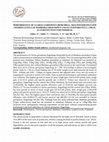
SUBSAHARN JOURNAL OF MULTIDISCIPLINARY RESEARCH AND INNOVATION, 2024
The performance of Clarias gariepinus fingerlings fed graded levels of Bambara groundnut (Vigna s... more The performance of Clarias gariepinus fingerlings fed graded levels of Bambara groundnut (Vigna subterranean) meal as substitution for fishmeal was evaluated. Five (5) isonitrogenous (40% crude protein) were formulate. Where Bambara groundnut as substitute for fishmeal was included at; 0.0g/100g (TB0), 5.00g/100g (TB1), 10.00g/100g (TB2), 15.00g/100g (TB3) and 20.00g/100g (TB4) graded levels, diet without Bambara groundnut (TB0) served as the control diet. Formulated diets were fed to Clarias gariepinus fingerlings (n = 300, 10.0±0.00g) in fifteen (15) rectangular plastic tanks (n = 20) at a fixed feeding rate of 3% body weight twice daily between the hours of 8:00 - 9:00am and 4:00 - 5:00pm at regular interval and adjusted after every two (2) weeks of sampling for a period of twelve (12) weeks. Data on growth performance and nutrient utilization was collected. The highest growth in terms of mean weigh gain (136.0±0.09 g/fish), daily weigh gain (1.61±0.13 g/day) and specific growth rate (1.39±0.11 %/day) was observed in Clarias gariepinus, fingerlings fed the control diet (TB0). Similarly, the least (best) feed conversion ratio (1.85±0.84), the highest (best) protein efficiency ratio (1.35±0.32) and highest survival rate (90.8±1.17 %) was recorded in Clarias gariepinus, fingerlings fed the control diet (TB0). While, the least growth in terms of mean weigh gain (91.0±0.48 g/fish), daily weigh gain (1.08±0.09 g/day) and specific growth rate (1.19±0.21 %/day) was observed in Clarias gariepinus, fingerlings fed diet TB4. Also, the highest (poor) feed conversion ratio (2.76±0.86), the least (poor) protein efficiency ratio (0.90±0.57) and lowest survival rate (80.20±1.14 %) was recorded in Clarias gariepinus, fingerlings fed diet TB4. Findings from this study indicated that, Bambara groundnut (Vigna subterranea) meal has the potential to substitute fishmeal by up to 5.00g/100g feed inclusion level, subsequently reducing expenditure on fish meal, without compromising growth performance and feed utilization in Clarias gariepinus fingerlings.
SUBSAHARAN JOURNAL OF MULTIDISCIPLINARY RESEARCH AND INNOVATION, 2024
Proximate and Phytochemical composition of ginger were analysed to find out its utility as a pote... more Proximate and Phytochemical composition of ginger were analysed to find out its utility as a potential feed/feed additive for ruminant livestock. The results of proximate analysis revealed the presence of dry matter (97.20%), crude protein (11.36%), crude fibre (12.28%), ether extract (5.90%), Nitrogen free extract (60.29%) and ash (7.37%). However, the quantitative phytochemical analysis indicated a higher presence of oxalate and flavonoid, compared to other phytochemicals that is tannins, saponnins, alkaloids and phenols. The presence of these primary and secondary metabolites indicated that the plant would serves as feed/feed additives for ruminant livestocks when used in appropriate quantity.

SUBSAHARAN JOURNAL OF MULTIDISCIPLINARY RESEARCH AND INNOVATION, 2024
Snake venom is a complex mixture of many proteins, peptides, enzymes and other chemical substance... more Snake venom is a complex mixture of many proteins, peptides, enzymes and other chemical substances that are responsible for wide broad of biological activities and toxicity. The Black-necked spitting cobra (Naja nigricollis), contains high abundance of PhospholipaseA2 (PLA2), responsible for neurotoxic and cytotoxic effect that are life threatening to human. This study focused on the neutralizing activities of crude serum anti-PhospholipaseA2 against toxic effect of Naja nigricollis venom PLA2. The serum anti-PhospholipaseA2 were produced from rabbits hyper immunized with Naja nigricollis snake venom. The venom LD50 value was calculated by probit method, with an LD50 of 1.73mg/kg body weight after subcutaneous administration of variable doses of venom in Wistar rats. The incubated mixture of crude serum anti-PhospholipaseA2 and Naja nigricollis venom followed by addition of crude egg yolk (substrate), reduced the activity of PLA2 in dose dependent manner as the sample treated with 100 μl/ml, 300μl/ml, 400μl/ml and 500μl/ml revealed 3.071 ± 0.18 μmol/min, 2.067 ± 0.18 μmol/min, 1.933 ± 0.18 μmol/min and 1.301 ± 0.06 μmol/min respectively. They significantly (p< 0.001) reduced the PLA2 activity when compared with untreated samples (5.133 ± 0.11μmol/min). The result of this study shows decrease crude PLA₂ activity in dose dependent manner and also, revealed the local production of specific naja nigricollis snake venom anti-PhospholipaseA2 suggesting for further anti-PhospholipaseA2 purification and specification analysis.
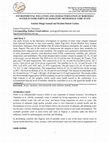
SUBSAHARAN JOURNAL OF MULTIDISCIPLINARY RESEARCH AND INNOVATION, 2024
The study focuses on the laboratory investigation on qualities of some water samples obtained fro... more The study focuses on the laboratory investigation on qualities of some water samples obtained from selected boreholes in four areas namely; Sabon Pegi (S1), Waziri Ibrahim (S2), Federal Polytechnic Damaturu (S3) and Malali (S4) all within Damaturu metropolis, the capital of Yobe State, Nigeria. The aim of the work is to characterize the samples to know their suitability for drinking when compared with some standards. The samples were analyzed to determine the levels of some parameters (arsenic, total dissolved solid (TDS), conductivity, turbidity, pH, chlorine, temperature and molybdate). The result obtained shows arsenic content in samples S1, S2, S3 and in S4 arsenic was not detected. The TDS in S1, S2, S3 and S4 were 30.16 ppm, 80.79 ppm, 79.41 ppm and 77.92 ppm respectively. The conductivity in S1, S2, S3 and S4 were599.4 μs/cm, 161.3 μs/cm, 158.8 μs/cm and 155.6 μs/cm respectively. The turbidity in S1, S2, S3 and S4 were 1.50 NTU, 6.95 NTU, 4.45 NTU and 1.21 NTU respectively. The pH value in S1, S2, S3 and S4 were 7.0, 6.8, 7.2 and 7.0respectively. The temperature level in S1, S2, S3 and S4 was on the average at 28ºC. The level of chlorine in S1, S2, S3 and S4 was 0.01mg/l. The amount of molybdate in S1, S2, S3 and S4 was 7.77 mg/l, 5.86 mg/l, 10.20 mg/l and 12.35 mg/l respectively. The results within the World Health Organization (WHO) standards except for conductivity and turbidity which show high contents in all the samples, which could cause health hazard to the community. It is recommended that the level of turbidity should be controlled so as to safe guard the health of the community.
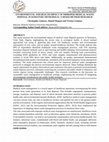
SUBSAHARAN JOURNAL OF MULTIDISCIPLINARY RESEARCH AND INNOVATION, 2024
This study assesses the environmental impact of medical waste disposal practices in Damaturu, Yob... more This study assesses the environmental impact of medical waste disposal practices in Damaturu, Yobe State, Nigeria, highlighting the severe risks to ecological health. A mixed method approached was using in gathering data from 150 healthcare workers and environmental assessments of soil, water, and air quality around healthcare facilities. The results indicate that 68% of respondents identified inadequate waste management practices, with 55% reporting hazardous disposal methods such as open burning and landfill dumping. Environmental analyses revealed concerning levels of heavy metals, with soil samples showing lead concentrations exceeding WHO guidelines by 120%, and water samples contaminated with pharmaceutical residues at levels 60% above safe limits. Additionally, air quality assessments demonstrated elevated particulate matter concentrations, correlated with increased respiratory issues among local residents. The study underscores the critical need for improved medical waste management protocols to mitigate the adverse environmental impacts observed. These findings illuminate the urgent requirement for policy interventions and community education to promote environmentally sound disposal practices, ultimately protecting the ecosystem and public health in Damaturu and similar regions facing comparable challenges. This research contributes to the discourse on sustainable waste management in healthcare settings, emphasizing the necessity of integrating environmental considerations into public health strategies.

SUBSAHARAN JOURNAL OF MULTIDISCIPLINARY RESEARCH AND INNOVATION, 2024
The cultivated tomato, Solanum lycopersicum, is grown for its popular fleshy fruits, also world's... more The cultivated tomato, Solanum lycopersicum, is grown for its popular fleshy fruits, also world's most processed vegetable accounting for more than 60% of global vegetable production in 2016 (PCW, 2016). The aim of this study is to determine the effect of organic manure and inorganic fertilizers on growth and yield of some varieties of tomato (Solanum lycopersicum L). An open field experiment was carried out in the University Farm of Federal University, Dutse, Jigawa state, in the Sudan savanna climatic zone of North-Western Nigeria. Three varieties of tomatoes were selected on the basis of yield, taste quality and good paste quality. Thus, Clause Rio Grande, Golden Quality UC82B and Semetes varieties were selected. The seeds were sourced from Jigawa State Agricultural Seed Company, JASCO. Organic manure and inorganic fertilizer were used at different levels as a treatment in this research. The treatments were: Poultry Manure (PM) at (0%, 25%, 50%, 75% and 100%). The inorganic fertilizer included five treatments of NPK fertilizer, which were NPK 15:15:15 (NPK-1) at (0%, 25%, 50%, 75% and 100%). A total of (15) treatment combinations were used in this experiment and replicated three (times). The (O75I25) treatment consistently yielded taller higher plant heights when compared to the other treatments combinations in Clause Rio Grande. On the other hand, the Control treatments tended to result in lower growth and yield parameters. While O50I50 treatment recorded highest growth and yield parameters for Golden Quality. For Semetes O25I75 treatment combinations recorded the highest growth and yield parameters. The study concludes that for Clause Rio Grande combination of 75% organic and 25% inorganic manure (O75I25) consistently produced the most favorable outcomes for growth and yield parameters, for Golden Quality O50I50 and O25I75 for Semetes variety.
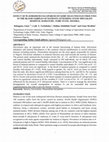
SUBSAHARN JOURNAL OF MULTIDISCIPLINARY RESEARCH AND INNOVATION, 2024
Electrolytes play an important role in the normal functioning of human body. Electrolyte imbalanc... more Electrolytes play an important role in the normal functioning of human body. Electrolyte imbalance and mineral disturbances is the common clinical manifestation in several infectious diseases including malaria.. Plasmodium falciparum are the main agents responsible for malaria in Nigeria. Electrolyte imbalance in malarial infection may lead towards the severity of disease. The present study analyzed the electrolytes levels (Na+, K+, Cl-, and HCO3-) in malarial patients and control (healthy individuals). Study consisted of 250 individuals, out of which 125 were malarial patients and 125 control healthy individuals. Concentrations of Na+ was significant in the blood of malarial patients as compared to control (healthy individuals) (P ≤ 0.05), but on K+, Cl- and HCO3- levels were not significant in the blood of malarial patients as compared to control (healthy individuals) (P ≤ 0.05). With regards to gender, Na+ and K+ level are lower on female than the male, this shows significant differences among them but on CL- and HCO3- No variation was noticed in electrolytes levels (P ≤ 0.05). Concentrations of electrolytes (Na+, K+, CL- and HCO3-) levels with parasite density in the blood samples of malarial patients (P. falciparum) also shows no significant variation in all the variables P ≤ 0.05. Levels of Na+, K+, Cl- and HCO3- are influenced by the presence of P. falciparum malaria. There is a need to manage the electrolyte derangements for overall management of malaria. It can be concluded that mineral supplementation may help to prevent disease severity.

SUBSAHARAN JOURNAL OF MULTIDISCIPLINARY RESEARCH AND INNOVATION, 2024
Fish feed constitutes about 60% of the total operational costs of a fish farm. Commercial feeds a... more Fish feed constitutes about 60% of the total operational costs of a fish farm. Commercial feeds are often too expensive for fish farmers. Consequently, farmers use locally available fish feed ingredients including agricultural by-products. These feed ingredients have led to increased pond productivity due to their nutrients constituent and bio-availability. Heterobranchus bidorsalis is an important farmed fish in Africa including Nigeria hence the need for research on its nutrition and growth performance. The growth performance and cost-benefit of using fermented millet bran meals diets on H. bidorsalis was evaluated in this study. Five isonitrogenous diets were formulated from fermented millet bran. The diets were fed to H. bidorsalis fingerlings (mean initial weight of 6.17±0.24g), in triplicates for 3 months. The pelleted diets showed significantly better performance (P<0.05) compared to control diet. Fish fed 100% inclusion level diet (D5) had the highest mean weight (MWG), average daily growth (ADG), specific growth rate (SPR) and relative growth rate (RGR) of 55.45±0.82g, 0.66±0.53, 1.19±0.62 and 888.62±0.63 while the lowest was obtained the fish fed control diet (D1) with 28.97±0.54g, 0.35±0.54, 0.91±0.65 and 476.48±1.05 respectively. The cost benefit analysis of the study indicated positive net profit and cost benefit ratio in the fish fed D5 with ₦23.56±0.93 and ₦0.38±0.05 while the lowest was obtained in the fish fed control diet (D1) with ₦5.96±0.72 and ₦0.11±0.02 respectively. This paper demonstrates that, fermented millet bran meals diets are cost-effective and should be incorporated as an essential part of the feed production.
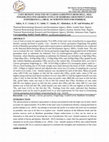
SUBSAHARAN JOURNAL OF MULTIDISCIPLINARY RESEARCH AND INNOVATION, 2024
Cost of feed accounts for approximately 70 to 89% of the total costs of production in aquaculture... more Cost of feed accounts for approximately 70 to 89% of the total costs of production in aquaculture thereby causing declined in profits. Cost - benefit of Clarias gariepinus fingerlings fed graded levels of Bambara groundnut (Vigna subterranea) meal as substitution for fishmeal was conducted at the National Biotechnology Research and Development Agency, Billiri, Gombe State. The aim was to evaluate the cost - benefit of Clarias gariepinus fingerlings using graded levels of Bambara groundnut meal as substitute for fishmeal. Five (5) isonitrogenous (40% crude protein) were formulate. where Bambara groundnut as substitute for fishmeal was included at; 0.0g/100g (TB0), 5.00g/100g (TB1), 10.00g/100g (TB2), 15.00g/100g (TB3) and 20.00g/100g (TB4) graded levels, diet without Bambara groundnut (TB0) served as the control diet. Formulated diets were fed to Clarias gariepinus fingerlings (n = 300, 10.0±0.00g) in fifteen (15) rectangular plastic tanks (n = 20) at a fixed feeding rate of 3% body weight twice daily between the hours of 8:00 - 9:00am and 4:00 - 5:00pm at regular interval and adjusted after every two (2) weeks of sampling for a period of twelve (12) weeks. Cost - benefit analysis was calculated for each of the diets. Mean net profit value ((₦115.00) was highest in fish fed the control diet (TB0), profit index value (2.79) was highest along with the least (best) incidence of cost value (₦0.31) and the highest benefit cost ratio value (1.44), in fish fed diet TB4, while mean net profit value (₦86.00) was least in fish fed diet TB3, profit index value was least (1.55) in fish fed control diet (TB0). Incidence of cost value (₦0.50) was highest (poor) in fish fed diet control diet (TB0) and the value (₦0.31) was least (better) was in fish fed diet TB4, while benefit cost ratio value (1.44) was highest in fish fed diet TB4, and least (1.01) in fish fed diet TB2. Findings from this study indicated that Bambara groundnut meal can be used in graded level or as total replacement for fish meal in formulating Clarias gariepinus feed without compromising the cost - benefit.

SAMRI JOURNAL, 2024
Nigerian Army barracks are known to accommodate animal production ventures especially by wives of... more Nigerian Army barracks are known to accommodate animal production ventures especially by wives of army personnel. However, there was no documented data on animal disease surveillance and notification systems in army barracks. The barracks are not exempted from animal disease outbreaks. This study to determine the proportion of farmers who report disease occurrences to relevant authorities and the reasons for non-notification of diseases in Ipaja Barrack. The study was a cross-sectional survey with administration of questionnaire designed with KoboTool Box application. The questionnaire was administered to 38 farmers and data on their socio-demographic characteristics, farm demography, disease frequency, out break and notification status were obtained. Data were analysed using descriptive statistics. The mean age of respondents was 42.1 ± 12.5 years. Of the 38 farmers, 20 (52.6%) were females, 32 (84.2%) were graduates of higher institutions of learning and all the respondents were married. Only 25 (65.8%) farmers reported to have experienced disease outbreaks, and all (100%) of them did not notify disease occurrence to relevant authorities. The most reasons for non-notification of diseases was not being aware [16 of 25 (64.0%)], while the least reasons were fear of stigmatization [3 of 25 (12.0%)], limited access to the farms because of location in barracks [3 of 25 (12.0%)] and not knowing who to report 25 (12.0%). Poultry farmers in the barracks do not notify disease occurrence to relevant authorities due to ignorance. Public education on diseases reporting and notification is recommended among poultry farmers within barracks.

SUBSAHARAN JOURNAL OF MULTIDISCIPLINARY RESEARCH AND INNOVATION
A study was conducted in three Local Government Areas (LGAs) of Yobe State to find out the farmer... more A study was conducted in three Local Government Areas (LGAs) of Yobe State to find out the farmer's perception on the utilization of sesame (sesamum indicum) pods as feed for ruminant animals. Purposive sampling method was used to select three villages in each of the local government Area. Checklist was used to obtained data from ten (10) respondents in each village, making a total of 30 respondents in each local government area, making a grand total of 90 respondents in the state. Data generated from the study were subjected to descriptive statistics (using frequency and percentile), Results obtained indicates that (42.22%) of the respondents used the pods for feeding goat, (30.00%) for feeding sheep and (15.56%) for feeding cattle. (66.67%) of the respondents sourced the pods from the farm and (33.33%) from market. Majority (71.11%) of the respondents are feeding the animals with the pods in combination with other feed ingredients while (28.89%) feds the pods alone. Among the respondents, (40.00%) used to combined the pods with millet bran, (32.22%) with wheat offal, (14.44%) with cowpea hay, (7.78%) with cowpea husk and (5.56%) with other feed ingredients. (50.00%) used the pods for both fattening and lactation while (44.44%) and (5.56%) of the respondents used the pods for fattening and lactation respectively. On availability, (65.56%) of the respondents testify that the pods are available, (26.67%) claimed it is partially available and only (7.78%) said it is not available. About the season of its availability, majority of the respondents (84.44%) testified that the pod is available during dry season. The study concluded that the farmers are using sesame as part of their ruminants feed component in fattening/lactation, indicating its potential use as a feed in the dry season when feed resources are not available.
Book Reviews by SUBSAHARAN JOURNAL OF MULTIDISCIPLINARY RESEARCH AND INNOVATION

SUBSAHARAN JOURNAL OF MULTIDISCIPLINARY RESEARCH AND INNOVATION, 2024
Hydroponic fodder production is an emerging, efficient and promising alternative method to tradit... more Hydroponic fodder production is an emerging, efficient and promising alternative method to traditional livestock feed production methods. If properly utilized, hydroponic fodder system is capable of ensuring supply of rich and sufficient fodder for livestock farmers most especially in areas facing insecurity and climatic challenges. Today insecurity is among the major threats facing smallholder farmers in northern Nigeria. The destructive impacts of insecurity are antithetical to farming activities and as such, must of the farmers abandoned their farm land due to different form of insecurity ranging from armed conflicts, kidnapping and other forms of terrorism which directly affected green fodder and other animal feeds obtainable from crop cultivation, consequently affecting livestock production as feed accounts for a major portion of livestock production cost. Therefore, it is in light of these reasons this work was prepared to provide an over view on hydroponic fodder production technology as a potential alternative to fodder production.









Uploads
Papers by SUBSAHARAN JOURNAL OF MULTIDISCIPLINARY RESEARCH AND INNOVATION
Book Reviews by SUBSAHARAN JOURNAL OF MULTIDISCIPLINARY RESEARCH AND INNOVATION